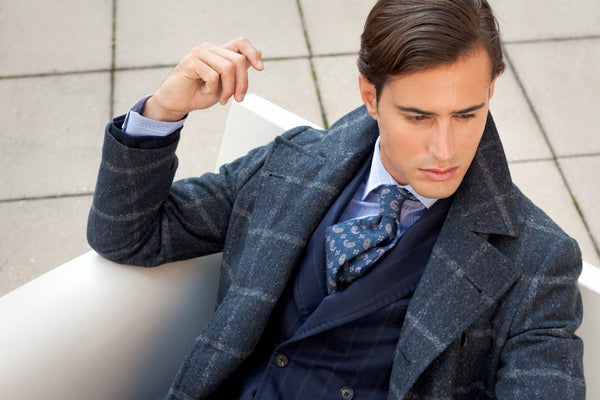An introduction to the men’s overcoat
There are few things in life that scream dapper like a meticulously crafted woolen coat fit snugly on a well suited, well dressed gentleman smack in the middle of winter. The overcoat has become a winter staple for the dapper gentleman, and just as we have with bespoke suits and shirts, have found that it is absolutely imperative to highlight the fabric, stylistic and functional elements of a well made overcoat, so as to ensure that next time you step out of your house, you are not only wearing a coat that makes you look good, but wearing one that also allows you to move well. So without further ado, here is our introduction to the men’s overcoat:
Overcoat summary
Crafted from heavy fabric such as wool, the overcoat is a long sleeved coat that can be either single or double breasted, and usually has a single vent at the back. Technically speaking, an overcoat should extend below the knee, but modern day overcoats often tend to sit just at the knee. We will discuss adjustments that can be made to the overcoat if it is custom tailored that will allow you full flexibility even in the event that it is significantly below your knees.
The top coat, a variation of the overcoat, is often confused by people. A topcoat extends to the knee at most and is typically constructed of a lighter fabric.
Fabric
If you are looking for an overcoat that will stand the test of time, your best bet is to invest in a 100% wool coat that has substantive weight to it. Overcoats made entirely of wool will keep you warm in the winter months and will be less susceptible to wear and tear. While a cashmere coat can infuse a greater sense of elegance into your coat, please note that cashmere is likely to show wear and tear at the cuffs and collar quicker than a 100% woolen design would.
If you know that you are definitely looking for something more classy than a plain woolen overcoat, a wool cashmere blend would be a good option to settle for.
Fit
When trying on that elusive overcoat you’ve had your eyes on, ensure that you are wearing a full suit, in order to accurately measure fit. Just is as the case with a suit, you want to be looking for a fit that flatters your form, neither restrictively slim nor oversized.
Length - you can choose between a traditional full-length style or something more modern and contemporary that finishes above the knee (will get into style details below as to how you can choose a full length overcoat while still retaining functionality). Please note that shorter (knee length or slightly above) overcoats are best suited for men with trimmer, slimmer builds. Men who are slightly larger may consider a longer overcoat.
Sleeves – Your overcoat sleeves should completely cover the suit sleeve as well as the shirt cuff, and even reach a little further down. This will prevent you from getting cold when you have your gloves on.
Stylistically, I personally prefer the longer overcoat, but that may be because I like to maintain some traditionalism with respect to my attire. For those of you going with the trends, and are of a slimmer build, a shorter overcoat would work wonders for you!
Style
While a double breasted overcoat is more formal and is generally best suited with formal attire, a single breasted overcoat will allow you to look dapper without the additional bulk, and will also prove to be a versatile piece when dressing business casual.
Just as you would with a suit, one can fine tune details on an overcoat, especially if it is bespoke. Lapel types, colored button stitching and button types are all examples of details that can be paid attention to. Just as with a suit, note that a peaked lapel will best suit a taller, simmer gentleman as it would accentuate his facial and body structure.
Colored button hole stitching is another fine detail that can show you have gone above and beyond with respect to your overcoat.
Belts – loops that allow for a fabricated belt of the same type as the overcoat will give you a more snug fit and provide an extra stylistic element!
Details such as inserts below the side pockets of your overcoat will ensure ease of access to your trouser pockets without having to lift your overcoat up every time. This subtle but important detail will ensure full functionality even while wearing a longer overcoat, while at the same time allowing you to look at your dapper best. This is a feature that we would highly recommend for those of you choosing to go with longer overcoats.
Construction
A high quality overcoat will feature a sewn canvas, whereas less expensive overcoats are constructed of a fused canvas. A sewn canvas is more durable and will stand up well against the test of time, whereas a fused canvas could undergo wear and tear. However, given that an overcoat is not as worn as often as a suit, a fused canvas should get the job done.
Accessorizing
When donning accessories with your overcoat, nothing looks more classy than winter or fall colors and / or textures complementing your overcoat. Instead of that pastel colored silk tie, opt for a navy blue, burgundy or olive green. And if you can, try using a woolen tie, offset by a silk pocket square, for added effect and textural variation!

A woolen overcoat with a woolen tie used to great effect! Courtesy of men's fashion blog trashness www.trashness.com
What are your views on wearing an overcoat? We would love to hear your comments below!
Please feel free to view our line of ties, pocket squares & lapel flowers here at The Dark Knot!

